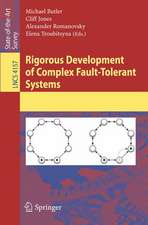Concurrency in Dependable Computing
Editat de Paul Ezhilchelvan, Alexander Romanovskyen Limba Engleză Hardback – 30 mai 2002
Application level structuring of concurrent activities. Concepts such as atomic actions, conversations, exception handling, view synchrony, etc., are useful in structuring concurrent activities so as to facilitate attempts at coping with the effects of component failures.
Replication induced concurrency management. Replication is a widely used technique for achieving reliability. Replica management essentially involves ensuring that replicas perceive concurrent events identically.
Application of concurrency formalisms for dependability assurance. Fault-tolerant algorithms are harder to verify than their fault-free counterparts due to the fact that the impact of component faults at each state need to be considered in addition to valid state transitions. CSP, Petri nets, CCS are useful tools to specify and verify fault-tolerant designs and protocols.
Concurrency in Dependable Computing explores many significant issues in all three strands. To this end, it is composed as a collection of papers written by authors well-known in their respective areas of research. To ensure quality, the papers are reviewed by a panel of at least three experts in the relevant area.
| Toate formatele și edițiile | Preț | Express |
|---|---|---|
| Paperback (1) | 990.62 lei 6-8 săpt. | |
| Springer Us – 28 oct 2010 | 990.62 lei 6-8 săpt. | |
| Hardback (1) | 998.04 lei 6-8 săpt. | |
| Springer Us – 30 mai 2002 | 998.04 lei 6-8 săpt. |
Preț: 998.04 lei
Preț vechi: 1247.55 lei
-20% Nou
Puncte Express: 1497
Preț estimativ în valută:
190.97€ • 199.39$ • 158.06£
190.97€ • 199.39$ • 158.06£
Carte tipărită la comandă
Livrare economică 04-18 aprilie
Preluare comenzi: 021 569.72.76
Specificații
ISBN-13: 9781402070433
ISBN-10: 1402070438
Pagini: 332
Ilustrații: XVIII, 310 p.
Dimensiuni: 155 x 235 x 23 mm
Greutate: 0.72 kg
Ediția:2002
Editura: Springer Us
Colecția Springer
Locul publicării:New York, NY, United States
ISBN-10: 1402070438
Pagini: 332
Ilustrații: XVIII, 310 p.
Dimensiuni: 155 x 235 x 23 mm
Greutate: 0.72 kg
Ediția:2002
Editura: Springer Us
Colecția Springer
Locul publicării:New York, NY, United States
Public țintă
ResearchDescriere
Concurrency in Dependable Computing focuses on concurrency related issues in the area of dependable computing. Failures of system components, be hardware units or software modules, can be viewed as undesirable events occurring concurrently with a set of normal system events. Achieving dependability therefore is closely related to, and also benefits from, concurrency theory and formalisms. This beneficial relationship appears to manifest into three strands of work.
Application level structuring of concurrent activities. Concepts such as atomic actions, conversations, exception handling, view synchrony, etc., are useful in structuring concurrent activities so as to facilitate attempts at coping with the effects of component failures.
Replication induced concurrency management. Replication is a widely used technique for achieving reliability. Replica management essentially involves ensuring that replicas perceive concurrent events identically.
Application of concurrency formalisms for dependability assurance. Fault-tolerant algorithms are harder to verify than their fault-free counterparts due to the fact that the impact of component faults at each state need to be considered in addition to valid state transitions. CSP, Petri nets, CCS are useful tools to specify and verify fault-tolerant designs and protocols.
Concurrency in Dependable Computing explores many significant issues in all three strands. To this end, it is composed as a collection of papers written by authors well-known in their respective areas of research. To ensure quality, the papers are reviewed by a panel of at least three experts in the relevant area.
Application level structuring of concurrent activities. Concepts such as atomic actions, conversations, exception handling, view synchrony, etc., are useful in structuring concurrent activities so as to facilitate attempts at coping with the effects of component failures.
Replication induced concurrency management. Replication is a widely used technique for achieving reliability. Replica management essentially involves ensuring that replicas perceive concurrent events identically.
Application of concurrency formalisms for dependability assurance. Fault-tolerant algorithms are harder to verify than their fault-free counterparts due to the fact that the impact of component faults at each state need to be considered in addition to valid state transitions. CSP, Petri nets, CCS are useful tools to specify and verify fault-tolerant designs and protocols.
Concurrency in Dependable Computing explores many significant issues in all three strands. To this end, it is composed as a collection of papers written by authors well-known in their respective areas of research. To ensure quality, the papers are reviewed by a panel of at least three experts in the relevant area.
Cuprins
Introduction. Preface. Part I: Role of Modelling and Formalisms for Dependable System Design. 1. Compositional Development in the Event of Interface Difference; J. Burton, et al. 2. Model-Based Design of Dependability; A. Arora, et al. 3. TLA Specification of a Mechanism for Concurrent Exception Handling; A.F. Zorzo, et al. 4. Component Based Dependable System Modelling for Easier Verification; D. Buchs, et al. Part II: Application Specific Modelling for Dependable Design and Analysis. 5. Digging into Concurrency; A. Chandler, et al. 6. Deadlock Free Control in Automated Guided Vehicle Systems; M.P. Fanti. 7. Quality Analysis of Dependable Information Systems; A. Zarras, V Issarny. Part III: Event Ordering and its Application. 8. Fault-Tolerant Sequencer; R. Baldoni, et al. 9. QoS Analysis of Group Communication Protocols in Wireless Environment; A. Bondavalli, et al. 10. Semantically Reliable Broadcast; J. Pereira, et al. 11. Exception Handling in Timed Asynchronous Systems; R. Miller, A. Tripathi. Part IV: Transactions and Consistent Checkpointing. 12. A Recovery Model for Cooperative Computations; E. Nett, M. Mock. 13. Group Transactions; M. Patiño-Martínez, et al. 14. Checkpointing in Distributed Computing Systems; L. Kumar, et al. Part V: Concurrency in Real-Time Applications. 15. Concurrency in Time Triggered Message-Triggered Objects with Service Time Guarantees; K.H. (Kane) Kim.




























